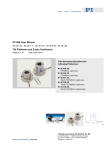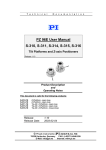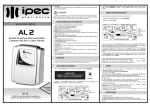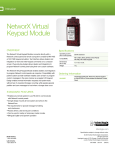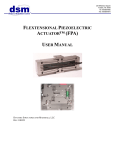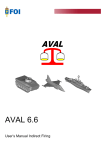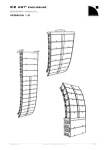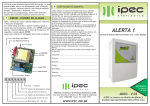Download User Manual PZ148E
Transcript
PZ 148E User Manual S-325 Piezo Tip/Tilt Platform and Z-axis Positioner Release: 1.0.0 Date: 2004-06-25 This document describes the following product(s): S-325.30L Tip-tilt / Z-Platform, Open-Loop S-325.3SL Tip-tilt / Z-Platform, Closed-Loop © Physik Instrumente (PI) GmbH & Co. KG Auf der Römerstr. 1 ⋅ 76228 Karlsruhe, Germany Tel. +49-721-4846-0 ⋅ Fax: +49-721-4846-299 [email protected] ⋅ www.pi.ws S-325 Tip-tilt / Z-Platforms User Manual PZ 148E Table of Contents 0. Safety Precautions ........................................................... 3 1. Introduction....................................................................... 4 1.1. Features....................................................................................... 4 1.2. Description ................................................................................... 4 1.3. Model Survey ............................................................................... 5 2. Mounting ........................................................................... 5 2.1. Mounting a mirror on the platform................................................ 5 2.2. Mounting the Platform on a Surface ............................................ 6 3. Operating........................................................................... 6 3.1. Read Before Operating ................................................................ 6 3.1.1. Travel Range ............................................................................... 6 3.1.2. Dynamic Behavior........................................................................ 6 3.2. Connecting to Controller and Starting.......................................... 7 4. Drive Electronics .............................................................. 8 5. Working Principle ........................................................... 10 6. Technical Data ................................................................ 11 6.1. Specifications............................................................................. 11 6.2. Dimensions ................................................................................ 13 6.3. S-325 Cable Configuration......................................................... 14 © Copyright 1998–2005 by Physik Instrumente (PI) GmbH & Co. KG Release: 1.0.0 File:S-325_User_PZ148E100.doc, 174592 Bytes Release 1.0.0 www.pi.ws Page 2 S-325 Tip-tilt / Z-Platforms 0. User Manual PZ 148E Safety Precautions Warning: Shock Hazard Voltages up to 130 V can be present on PZT connectors. Warning: Be Careful When Mounting Never use the holes on the top platform surface for mounting an object, since this could destroy the PZT actuators. Never put anything in the flexure gaps of the body. Do not clamp the body since this can block the flexure guiding system or reduce the travel range. Warning: Resonance Can Cause Permanent Damage The system must never be operated close to the resonant frequency, or permanent damage can result. If you hear or see resonant behavior, switch off the unit immediately. Remember that any mass mounted on the platform will reduce the resonant frequency dramatically. Release 1.0.0 www.pi.ws Page 3 S-325 Tip-tilt / Z-Platforms 1. User Manual PZ 148E Introduction The S-325 Z-positioners and multi-axis tip/tilt platforms are fast and compact units based on the triple-piezo-drive-supported platform design. All offer piston movement up to 30 µm and tilt movement up to ± 2.5 mrad with sub-msec response and settling. 1.1. Features ¾ Tip/Tilt Range up to ± 2.5 mrad (0.14°) ¾ Piston Movement up to 30 µm ¾ Compact Design ¾ Closed-Loop Versions ¾ For Mirrors up to 25 mm (1”) Diameter Fig. 1: S-325 1.2. Description S-325 tilt platforms are equipped with three low-voltage (0 to 100 V) piezoelectric linear drives spaced at 120° intervals. Control of the tip/tilt versions is complicated because expansion of an individual PZT actuator can affect both θX and θY rotation. External coordinate transformation (software or hardware) is required to allow platform position commands in θX and θY coordinates, and that hardware or software will determine how the tip/tilt angles are defined. See the equations and Fig. 2 on page 10 for examples. The triple-piezo-actuator design exhibits excellent angular stability over a wide temperature range. Temperature changes only affect the vertical position of the platform (piston motion)—and that only in open-loop operation—and have no influence on the angular position. The units can be mounted in any orientation. In open-loop operation, the position of each actuator roughly corresponds to the drive voltage (see the discussion on p. 10 for calculating vertical position / platform angle as a function of actuator extension and see the "Tutorial: Piezoelectrics in Positioning" in the PI catalog or at www.pi.ws for more on the behavior of openloop PZTs). The open-loop model (S-325.30L) is ideal for applications where the position is controlled by an external loop based on data provided by a sensor (e.g. quad cell, CCD chip). The closed-loop version (S-325.3SL) offers absolute position control, high linearity and repeatability based on the internal high-resolution feedback sensor. Release 1.0.0 www.pi.ws Page 4 S-325 Tip-tilt / Z-Platforms 1.3. User Manual PZ 148E Model Survey Two different versions are available: S-325.30L Open-loop Z, tip/tilt positioner; all three piezo linear actuators can be driven individually or in parallel by a three-channel amplifier. Vertical (piston movement) positioning and tip/tilt positioning are possible. S-325.3SL Closed-loop Z, tip/tilt positioner; all three piezo linear actuators are equipped with strain gauge position feedback sensors (SGS) and can be driven individually (or in parallel) by a three-channel amplifier/ position servo-controller. Vertical positioning (piston movement) and tip/tilt positioning are possible. The integrated position feedback sensors provide sub-µrad resolution and repeatability (with PI control electronics). 2. Mounting Warnings Never use the holes on the top platform surface for mounting an object since this could destroy the PZT actuators Never put anything in or across the gaps (flexure guiding system) of the body. Do not clamp the body since this can block the flexure guiding system and reduce the travel range. 2.1. Mounting a mirror on the platform You can mount the mirror on the platform surface using glue. Before gluing any mirror you should consider some important aspects: ¾ How flat does the mirror need to be? The greater the required flatness, the more care needs to be taken. This is primarily a matter of experience. ¾ Materials match: The S-325 platform is made of aluminum. Ideally, the mirror should be aluminum too (identical thermal coefficient of expansion). Alternatively, BK7 could be used (keeping in mind the points above). ¾ Choose glue that may be cured at room temperature (less stress is induced while drying/curing) and that shrinks as little as possible during the process. ¾ PI usually uses Scotch-weld 2216 B/A, a two component epoxy glue from 3M. It is cured at 25°C over a period of 24 h and has high shear strength. For a flatness/evenness of approx. λ/4 to λ/5 proceed as follows: 1. The S-325 top-platform has 3 holes spaced 120 degrees apart. Right in between these mounting holes (also 120 degrees apart) place one very small amount of glue each with a dosing apparatus. Each speck of glue should be approx. the size of half a pinhead. This will yield the recommended layer thickness of around 50 to 150 microns. 2. Briefly press the mirror on the platform (not too hard) and simply wait. Note that even when this is done carefully, and the above-mentioned flatness is achieved, the three glue spots will most likely be visible in a surface interferogram. A flatness/evenness better than lambda/5 can be achieved as follows: ¾ Use a thicker mirror (providing your dynamics will allow that). Release 1.0.0 www.pi.ws Page 5 S-325 Tip-tilt / Z-Platforms User Manual PZ 148E ¾ Instead of gluing the mirror directly to the platform, use a cross pole. This is a device that is mounted to the platform and which holds the mirror at the edge in three places. The mirror is then glued to this holder at the edges, so it is only stressed radially. However, the cross pole will also slightly reduce the dynamic performance, as there is additional weight and the center of gravity is shifted slightly towards the outside. Contact PI if you want to mount a cross pole. 2.2. Mounting the Platform on a Surface The platform can be mounted in any orientation. For attaching the S-325 to its mounting, use the 4 threaded holes (4 x UNC4-40) in the platform base plate (at the cable-exit end). See the drawings in Section 6.2 on p. 13 for details. By default, the platform metal case is electrically floating. You should ground it if so required. 3. Operating 3.1. Read Before Operating 3.1.1. Travel Range For maximum tilt range of the S-325, all three piezo actuators must be biased at 50 V. Linear travel and tilt angle are interdependent (see the discussion of tilt angles on page 10 for more information). The travel-range and tilt-angle values quoted in the documentation (see the technical data table on page 11) refer to maximal pure linear or pure angular motion. 3.1.2. Dynamic Behavior In addition to the amplifier, controller and sensor bandwidths, the maximum operating frequency of a tilt platform depends on its mechanical resonant frequency. To estimate the effective resonant frequency of a tip/tilt system (platform + payload), the moment of inertia of the payload must also be considered. Moment of inertia of a rotationally symmetric payload (e.g. round mirror): 2 3R 2 + H 2 H I m = m + +T 12 2 Moment of inertia of a rectangular payload (e.g. rectangular mirror): 2 L2 + H 2 H I m = m + +T 2 12 where: m = Payload Mass [g] IM = Moment of inertia of the payload [g·mm2] L =Payload length perpendicular to the tilt axis [mm] H = Payload thickness [mm] Release 1.0.0 www.pi.ws Page 6 S-325 Tip-tilt / Z-Platforms User Manual PZ 148E T = Distance, pivot point to platform surface (see technical data table on p. 11 for individual model) [mm] R = Payload radius [mm] Using the resonant frequency of the unloaded platform (see the technical data table, p. 11) and the moment of inertia of the payload, the system resonant frequency is calculated according to the following equation: Resonant frequency of a tip/tilt platform system (including payload): f '= f0 1+ IM I0 where: f' = Resonant frequency of platform with payload [Hz] f0 = Resonant frequency of unloaded platform [Hz] I0 = Moment of inertia of the unloaded platform (see technical data table) [g·mm2] IM= Moment of inertia of the payload [g·mm2] For more information on static and dynamic behavior of piezo actuators, see the "Tutorial" section of the PI Catalog, in particular pages 4-27 ff., or consult the same material at www.pi.ws → Products → Tutorial, (http://www.physikinstrumente.de/products/section4/content.php). 3.2. Connecting to Controller and Starting Warning: Shock Hazard Voltages up to 130 V can be present on PZT connectors. Make sure there is no voltage on the PZT output of the amplifier when you connect the platform to the controller. The best way to do so is to switch the controller off. The following instructions describe starting the S-325 tip/tilt platform using PI’s E500-series control electronics (E-500 or E-501 chassis including E-503.00 amplifier module and, when using the closed-loop model, E-509.S3 servo-control module). If you use other modules from the E-500 series or other amplifiers the steps are the same, but the connection details may differ1. In this case please consult the “Drive Electronics” Section on p. 8 for further information. Note: The correct PZT- and sensor-channel assignment must be observed when connecting the unit to the controller as the channels are individually calibrated. 1. Make sure the control electronics is switched off. 2. Closed-loop models (S-325.3SL) only: Connect the S-325 tip/tilt mirror to the servo-control module. The three sensor cables of the S-325, which have female LEMO connectors and are labeled “CH1”, “CH2” and “CH3”, must be plugged into the corresponding sockets of the servo-control module (labeled “SERVO 1” to “SERVO 3”). 3. Connect the S-325 tip/tilt platform to the amplifier module. The supply voltage cables of the S-325 have male LEMO connectors and are labeled “CH 1”, “CH 2” and “CH 3”. They must be plugged into the corresponding output sockets of the amplifier module (labeled “PZT”, pay attention to the correct channel assignment). 1 Amplifier/controller modules for OEM applications may have other connector types. Refer to the User Manual for the electronics for detailed information Release 1.0.0 www.pi.ws Page 7 S-325 Tip-tilt / Z-Platforms User Manual PZ 148E Warning: Resonance Can Cause Permanent Damage The system must never be operated close to the resonant frequency or permanent damage can result. If you hear or see resonant behavior, switch off the unit immediately. Remember that any mass mounted on the platform will reduce the resonant frequency dramatically. See “Dynamic Behavior” Section on p. 6 for more details. 4. Switch on the control electronics. Consult the E-500 User Manual, and, if you have an E-516 interface module installed, the E-516 E-User Manual for information on commanding the S-325 tip/tilt platform. If you have the closed-loop model, see also the User Manual of the servo-control module (E-509) for details on servo-control settings. Note that external coordinate transformation (software or hardware) is required to allow platform position commands in θX and θY coordinates. See the equations and Fig. 2 on page 10 for examples. Be aware that all three PZT actuators move down to the bottom limit of the travel range when you switch the amplifier off. 4. Drive Electronics Both the S-325 tip/tilt platform closed-loop and open-loop models can be controlled by electronics of the E-500 series. The S-325.30L open-loop models can be driven by the amplifiers listed below without a servo-controller. Amplifier (choice of the following, always required): E-503.00 Amplifier module; 3 channels E-505.00 Amplifier module; single-channel, 3 modules required, supply voltage cable “CH1” must be connected to the leftmost module, “CH2” to the center module and “CH3” to the rightmost E-505 E-663.00 Amplifier desktop unit; 3 channels, for open-loop S325.30L only E-610.00 OEM LVPZT Amplifier; single-channel, 3 units required, for open-loop S-325.30L only Release 1.0.0 www.pi.ws Page 8 S-325 Tip-tilt / Z-Platforms User Manual PZ 148E Controller (required for closed-loop operation): E-509.S3 Position servo-control module for SGS sensors; 3 channels, channel 1 (labeled “SERVO 1”) must be used with the platforms sensor cable “CH1”, second and third channel (input sockets “SERVO 2” and “SERVO 3”) accordingly. Required in addition to the E-50x amplifier module(s) listed above. E-610.S0 Single-channel SGS controller board for OEM applications consisting of an amplifier, a sensor supply and processing circuit, including preamplifier, demodulator, different filters and a proportional-integral (P-I) controller for open-loop \ closed-loop operation. Three units are required to drive an S-325.3SL. E-621.SR Single-channel SGS controller module offering RS-232 and I2C interfaces for computer control and networking, an amplifier, sensor supply and processing circuit including preamplifier, demodulator, different filters and a proportional-integral (P-I) servo-controller. Three units are required to drive an S-325.3SL. Computer Interface and Display Module (required for computer-controlled operation): E-516.i3* Computer Interface and Display Module, 3 channels For use with to the E-50x amplifier and the E-509.S3 position servo-control modules (listed above; all modules are in one chassis). *The discontinued E-515 can also be used. Release 1.0.0 www.pi.ws Page 9 S-325 Tip-tilt / Z-Platforms 5. User Manual PZ 148E Working Principle The three PZT actuators which support the platform are arranged symmetrically around the center point (see Fig. 2 at right). As you can see in Fig. 3 on p. 13, they come labeled as channels 1, 2 and 3, clockwise from the cable exit point. There are many ways to define the axes and tip/tilt angles. The definitions you use will depend on the geometry of your application. The geometry and formulas shown in b 2b Fig. 2 are based on a system with the a= 3, ∅ = 3 Y-axis passing through one of the 2 3 actuators (designated A) and the tilt Fig. 2 Triple-piezo-drive tip/tilt platform angles measured around fixed axes geometry, viewed from above. A, B, C are (i.e. the angles are measured in the three PZT drives. vertical planes, not planes necessarily perpendicular to the platform). For this example, the formulas below would be used to calculate α and β. These formulas show the relationship between the displacement of each actuator (from the bottom limit of the travel range = extension at 0 V) and the tip/tilt angles (in radians). It uses the sin α = α approximation, making it valid for small angles, covering the full travel range of the device. α = [A – ½(B+C)] / a β = (B-C) / b with A = constant Z = (A+B+C) / 3 where A, B, and C are the linear displacements of the corresponding piezo actuators (between 0 and 12 µm), α and β are the tilt motions in radians measured around fixed axes, Z is the linear displacement of the platform center point. Equation 1: Triple-piezo-drive relation Example: S-325 Ø = 11.6 mm a = 8.7 mm b = 10.0 mm A, B, C actuator range: 0 to 20 µm αmin = [Amin – ½(Bmax+Cmax)] / a = -20 µm / 8.7 mm = -2.3 mrad αmax = [Amax – ½(Bmin+Cmin)] / a = 20 µm / 8.7 mm = 2.3 mrad βmin = (Bmin-Cmax) / b = -20 µm / 10.0 mm = -2 mrad βmax = (Bmax-Cmin) / b = 20 µm / 10.0 mm = 2 mrad Z = 0 to 20 µm Release 1.0.0 www.pi.ws Page 10 S-325 Tip-tilt / Z-Platforms 6. Technical Data 6.1. Specifications User Manual PZ 148E Models S-325.30L S-325.3SL Active Axes θX, θY. Z θX, θY. Z Units Notes * Open-loop tilt angle @ 0 to **5 (±2.5) 100 V **5 (±2.5) mrad ±20% A2 * Closed-loop tilt angle - **4 (± 2) mrad A3 * Open-loop linear travel @ 0 to 100 V 30 30 µm ±20% A5 * Closed-loop linear travel @ 0 to 100 V 30 µm A6 Integrated feedback sensor - strain gauge sensor Closed-loop/open-loop angular resolution -/±0.05 0.1/±0.05 µrad C1 Closed-loop/open-loop linear resolution -/1.0 0.5/1.0 nm C1 Electrical capacitance 3 x 3.6 3 x 3.6 µF ±20% F1 Diameter (max.) of mounted mirrors/optics 25 25 mm Unloaded resonant frequency 2 2 kHz ±20% G2 Resonant frequency with 25 x 8 mm glass mirror 1 1 kHz ±20% G3 Distance of pivot point to platform surface 6 ±0.5 6 ±0.5 mm Platform moment of inertia 515 515 gmm2 Operating temperature range -20 to 80 -20 to 80 °C Voltage connection 3 x VL, 2.0 m 3 x VL, 2.0 m J1 Sensor connection - 3 x L, 2.0 m J2 Weight (without cables) 65 65 Material casing Aluminum Aluminum Recommended Amplifier/Controller E-500 system, E-663, 3 x E-610.00 E-500 system with E-509 controller, 3 x E-610.S0, 3 x E-621.SR B H2 g ±5% Notes *For maximum tilt range, all three piezo actuators must be biased at 50 V. Linear travel and tilt angle are interdependent. The values quoted here refer to pure linear / pure angular motion. See discussion on page 10 for more information. **Mechanical tilt, optical beam deflection is twice as large. A2 Open-Loop Tilt Angle @ 0 to 100 V Typical open-loop tilt angle at 0 to 100 V operating voltage. Max. operating voltage range is -20 to Release 1.0.0 www.pi.ws Page 11 S-325 Tip-tilt / Z-Platforms User Manual PZ 148E +120 V, (outside 0 – 100 V for short durations only). For details see "Lifetime of PZTs" in the "Tutorial" section of the PI catalog or at www.pi.ws → Products → Tutorial. A3 Closed-Loop Tilt Angle Tilt provided in closed-loop operation. PI LVPZT amplifiers have an output voltage range of -20 to +120 V to provide enough margin for the controller to compensate for load changes etc. A5 Open-Loop Linear Travel @ 0 to 100 V Typical open-loop travel at 0 to 100 V operating voltage. Max. operating voltage range is -20 to +120 V, (outside 0 – 100 V for short durations only). For details see "Lifetime of PZTs" in the "Tutorial" section of the PI catalog. A6 Closed-Loop Linear Travel Travel provided in closed-loop operation. PI LVPZT amplifiers have an output voltage range of -20 to +120 V to provide enough margin for the controller to compensate for load changes etc. B Integrated Feedback Sensor Absolute-measuring SGS (strain gauge sensors) are used to provide position information to the controller. For details see the "Tutorial: Piezoelectrics in Positioning" section of the PI catalog. C1 Closed-Loop / Open-Loop Resolution Resolution of piezo tilt platforms is basically infinitesimal because it is not limited by stiction/friction. Instead of resolution, the noise-equivalent motion is specified. Values are typical results (RMS, 1σ measured with E-503 amplifier module in E-500/501 chassis). D1 Stiffness Static large-signal stiffness of the PZT ceramic at room temperature. Small-signal stiffness and dynamic stiffness may differ because of effects caused by the active nature of the piezo material, compound effects, etc. Further details see "Tutorial" section of the PI catalog. F1 Electrical Capacitance The PZT capacitance values indicated in the technical data tables are small-signal values (measured at 1 V, 1000 Hz, 20º C, no load; large-signal values at room temperature are 30 to 50% higher). The capacitance of PZT ceramics changes with amplitude, temperature, and load, up to 200% of the unloaded, small-signal capacitance at room temperature. For detailed information on power requirements, refer to the amplifier frequency response curves in the "PZT Control Electronics" section of the PI catalog. G2 Unloaded Resonant Frequency (f0) Lowest tilt resonant frequency around active axis without mirror attached to platform (is above the maximum operating frequency). For further details see the "Tutorial: Piezoelectrics in Positioning" section of the PI catalog. G3 Resonant Frequency with Mirror Example of how a load (mirror) attached to the platform affects the resonant frequency (calculated data). See "Dynamic Behavior" in the PI catalog for further details. H2 Operating Temperature Range Standard range, other temperature ranges on request. Closed-loop systems are calibrated for optimum performance at room temperature. Recalibration is recommended if operation is at a significantly higher or lower temperature. J1 Voltage Connection Typical operating voltage connectors are LEMO-type connectors. VL (Voltage Low): LEMO FFA.00.250, male. Cable: coaxial, RG 178, Teflon coated. For extension cables and adapters, see "Accessories" in the "PZT Control Electronics" section of the PI catalog. J2 Sensor Connection Typical sensor connectors are LEMO-type connectors. L: LEMO FFA.0S.304, female. Cable: PUR. For extension cables and adapters, see "Accessories" in the "PZT Control Electronics" section of the PI catalog. Release 1.0.0 www.pi.ws Page 12 S-325 Tip-tilt / Z-Platforms 6.2. User Manual PZ 148E Dimensions Dimensions in mm, decimal places separated by commas in drawings Bottom View Top View Fig. 3: S-325 Tip-tilt / Z-Platform Release 1.0.0 www.pi.ws Page 13 S-325 Tip-tilt / Z-Platforms 6.3. User Manual PZ 148E S-325 Cable Configuration Fig. 4: S-325 cable configuration (upper picture S-325.30L, lower picture S325.3SL); cables labeled with PZT channel numbers and—if sensors are present—sensor channel numbers Release 1.0.0 www.pi.ws Page 14














